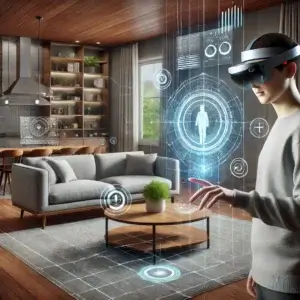How Total Internal Reflection Brings Augmented Reality to Life?
Augmented Reality (AR) along with Virtual Reality (VR) and Mixed Reality (MR) are the three major immersive reality technologies. These cutting-edge innovations are rapidly integrating into our daily lives, revolutionizing how we interact with the world. From gaming and entertainment to education and professional applications, AR, VR, and MR are transforming various industries by offering new levels of engagement and interactivity.
In this article we will diving into the scientific details of how total internal reflection (TIR) powers AR glasses by bending & reflecting light rays numerous times to create immersive realities. But before that, let’s have a brief understanding of what these immersive realities truly are.
Augmented Reality
Augmented Reality (AR) blends digital content with the real world, enhancing the user’s environment with computer-generated elements such as images, sounds, and other sensory inputs. This technology is widely used in various industries including gaming, retail, and education, offering interactive experiences through smartphones, tablets, and AR glasses. Popular examples include Pokémon GO and Snapchat filters.

Virtual Reality
Virtual Reality (VR) creates a fully immersive digital environment that completely replaces the real world. Users experience VR through headsets like Oculus Rift or HTC Vive, which track head movements to provide a 360-degree view of the virtual space. This technology is prominent in gaming, entertainment, and virtual tours, offering a completely immersive experience that transports users to different worlds or scenarios.

Mixed Reality
Mixed Reality (MR) merges real and virtual worlds to produce new environments where physical and digital objects coexist and interact in real-time. This technology goes beyond AR by allowing users to manipulate and interact with both physical and virtual elements. MR is often used in industrial design, healthcare, and immersive training simulations. Devices like Microsoft HoloLens exemplify MR’s capabilities, providing a more integrated experience.

Now let’s come back to the physics of how light rays operate to enable us to experience these immersive realities.
How Total Internal Reflection Works in AR Glasses?

Total internal reflection is a key principle that powers the waveguides in AR glasses. The AR glasses have thin& transparent layers embedded in them, called waveguides. These waveguides help project digital images and information into the user’s field of view. The high transparency of waveguides ensures that the user’s view of the real world is not significantly obstructed, maintaining situational awareness. This way waveguides enable the integration of virtual elements with the real world seamlessly and efficiently.
Here’s a detailed explanation of how waveguides work and their importance in AR glasses:
How Waveguides Work in AR Glasses?
- Light Injection:
- The process begins with a light source, usually a micro-display (such as OLED or LED), located at the edge of the waveguide.
- Light from the display enters the waveguide through an input coupler– a grating that directs light into the waveguide.
- Light Propagation:
- Once inside the waveguide, the light travels through the material by total internal reflection. This process keeps the light confined within the waveguide.
- Light Extraction:
- As the light travels, it encounters extraction gratings placed at specific locations within the waveguide.
- These gratings diffract the light out of the waveguide, directing it towards the user’s eyes.
- Image Formation:
- The extracted light forms an image that appears to float in the user’s field of view, overlaying digital information onto the real world.
- This image is typically sharp and clear, providing an augmented experience without obstructing the view of the real environment.
As Augmented Reality (AR), Virtual Reality (VR), and Mixed Reality (MR) continue to evolve, the underlying technologies like TIR will play an increasingly pivotal role in delivering more sophisticated and engaging experiences. Understanding the science behind these innovations not only highlights their current applications but also opens the door to future advancements that will further integrate these immersive realities into our daily routines.
To enhance your understanding of how TIR works, we encourage you to try our Total Internal Reflection Simulator. This tool will help you visualize how TIR, along with the overall refraction and reflection of light rays, giving you a clearer insight into the mechanics behind these groundbreaking technologies.



